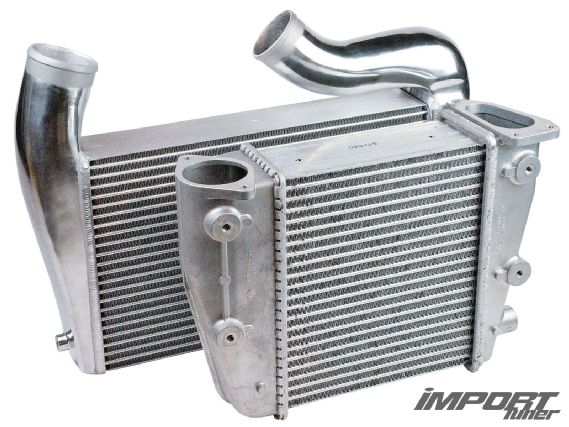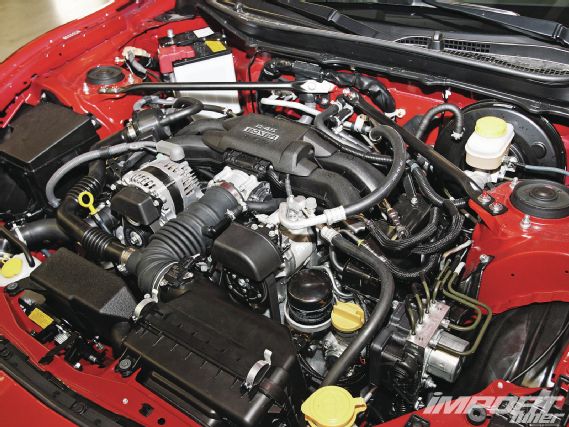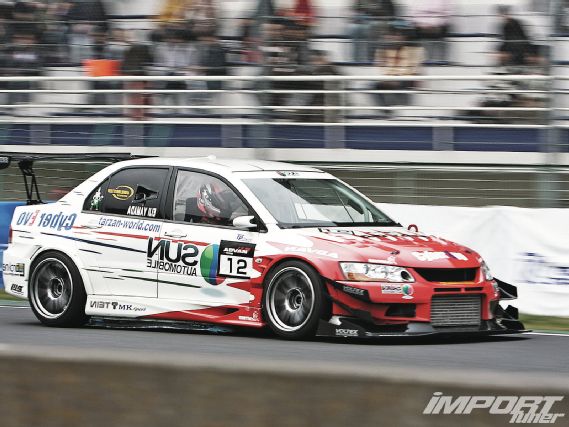 | IMPP-120700-QUEST
| IMPP-120700-QUEST
Got a burning question or simply need some advice with problems you've encountered while wrenching on your current/future projects? Ask our automotive guru Eric Hsu anything-literally, he's going to answer every single question, as long as it's automotive related.
Got a tech question? Send it to questionit@importtuner.com
Intercooler Efficiency
I've just been reading a few threads on the Internet related to intercoolers and have a couple questions. If the radiator used for cooling the engine has an electric fan to aid cooling, why doesn't the intercooler use a fan as well? If I were to add my own fan to the intercooler would it aid cooling enough for me to notice any change in performance?
 |
IMPP-120700-QUEST
|
IMPP-120700-QUEST
I'd like to hear your thoughts on the matter.
-Anonymous, via importtuner.com
Water carries the heat away that an engine produces at all speeds including when the car is at idle. As long as there is combustion, heat is being created that must be rejected by the radiator. A turbo is barely spinning when a car is at idle so there isn't any air being compressed and therefore no heat is being created. An intercooler doesn't need a fan because there's no heat that needs to be rejected. Sometimes drift cars use fans on the intercooler because there is boost being created at very low vehicle speeds. At high speeds when boost is usually being created, an intercooler generally has plenty of ambient airflow through the face of the core to help reject heat from the compressed air.
Fluttering BOV
I own a WRX that's my daily driver. When the car doesn't hit max boost, and I let off the throttle at about 3-5 psi, I get a flutter sound that's similar to most cars that don't hit full boost with a blow-off valve. I assume it's because there is not enough pressure to completely open the valve that causes it to flutter a bit. I've been told this is the same sound that drag cars with external wastegates make, which I'm reluctant to believe would cause the same type of noise. I'm hoping you can clear up this confusion.
-Ben Deyrod, Salt Lake City, UT
I'm not sure why people confuse wastegates and blow-off valves. Wastegates are on the exhaust side and BOVs are on the compressor side. How can they possibly have similar noises? When a wastegate opens, it sounds absolutely nothing like a blow-off valve. I can't really see the confusion except when somebody doesn't really know the difference between the two devices. I'm glad you're reluctant to believe what you've been told because that person who told you is probably a dumb ass or somebody who isn't very familiar with turbo engines.
Most BOVs use only a single hose connection on top of the diaphragm that relies heavily on engine vacuum to open the valve up. As far as your fluttering goes, I'm guessing that you're letting off the throttle from lower revs when the engine doesn't create much engine vacuum on deceleration. If you want to change the noise because you find it irritating, like I do, then you can either use a softer spring or loosen the spring preload adjustment, which allows less vacuum necessary to open up the BOV. On the flip side, using too little preload or too soft of a spring may cause the valve to open up at higher pressures causing boost to leak. Just make sure you're running a name-brand BOV and not some made-in-China eBay crap, and chances are you'll be fine on a street car.
EVO vs. STI
I was having a friendly discussion with my girlfriend's stepfather on which car [EVO or STI] was the more superior of the two. It was the usual discussion on platforms, but then he said something about how the EVO was created to compete against the STI. He proceeded to go into this tangent on how the STI was the original AWD turbocharged rally car that's far more superior in engine design, and the EVO was just an imitation. Do you guys have any dirt on which one was first produced, and which one is the better car just to get him irritated?
 |
Intercooler Efficiency, Fluttering BOV, EVO vs. STI and more! - Question It
|
Intercooler Efficiency, Fluttering BOV, EVO vs. STI and more! - Question It
-John Franklin, via importtuner.com
The first Impreza STI was released in 1990 while the first Lancer EVO was released in 1992, making the STI the first between the two. He did state a fact there. However, the rest of what he says is pretty much bull. Here's some information to help you school the your girlfriend's stepfather:
1. He is completely incorrect on the "original AWD turbocharged rally car" statistic that he force-fed you. The Audi Quattro debuted in 1980 in WRC.
2. Far more superior engine design? The Subaru has a hollow aluminum case that has two halves bolted together for a cylinder "block" and the EVO has a cast-iron block. Take a wild guess at which one is stronger, and then speak to STI owners with 100 percent bone-stock cars who have taken their '08-and-newer STIs in for broken pistons.
3. The cars are fundamentally different with the Subaru having a longitudinal drivetrain layout and the EVO having a transverse layout, so I would hardly call the EVO an "imitation".
Anyhow, try not to lay it on him too hard. After all you'll have to see him every time you pick your girlfriend up, so schooling him hard isn't exactly going to improve your relationship.
FR-S/BRZ Tunability?
I've been following the Scion FR-S and Subaru BRZ closely since the concept days. There's been plenty of talk as well as debate on the Internet in regards to the tunability of the Subaru's boxer engine with Toyota's D4-S fuel injection technology. What are some of the pros and cons with tuning using the D4-S system and will the 12:1 to 1 high compression become a limiting factor with tuning those cars?
 |
Intercooler Efficiency, Fluttering BOV, EVO vs. STI and more! - Question It
|
Intercooler Efficiency, Fluttering BOV, EVO vs. STI and more! - Question It
-Michael Flannigan, Richmond VA
I'm not 100 percent familiar with Toyota/Subaru's injection strategy of using both direct and port injectors, but tunability will largely depend on access to the stock ECU's maps. If ECU tuning companies, like Cobb Tuning, are able to crack the stock ECU, then that's step one. Direct injection engines are still internal combustion engines, and there's very likely something left on the table since the OEMs have to be conservative for warranty purposes. The 12:1 compression ratio isn't too high in the world of direct injected engines and 91-octane fuel, so I suspect that isn't going to be an issue either.
Step two is going to be the availability of parts. Are the high-quality parts manufacturers going to make bolt-on parts for these cars? We'll see. Hopefully the abundance of Chinese knock-off companies on eBay hasn't chased them away. I can tell you for sure to keep an eye on Greddy and Cosworth for FR-S and BRZ parts. Between the catalogs of the two companies, you'll probably be able to build the ultimate FR-S/BRZ.
Torque Wrench Quality?
I'm looking for a reliable torque wrench to correctly rebuild my engine. Why does everyone recommend I purchase a brand name versus a cheaper unit? Is there anything else to know? I'm a noob, so this will be my first one?
-Fred Vialobos, Ontario CA
Tools are a category of consumer goods where name brands still mean something. Tools are often used in extreme situations so quality is still an important factor. The name-brand companies, such as Mac Tools or Snap-On, spend more time designing, testing, and manufacturing their tools. Buying a name-brand tool almost always means you're getting a higher quality part. On the other hand, a quality tool in the hands of an idiot isn't any good either. Just like a $1,000 golf driver isn't going to make you drive further than Tiger Woods, a $300 torque wrench isn't going to do you any good if you prep the fasteners and surfaces incorrectly. In the case of fastener torque, make sure you clean the fasteners themselves and the surfaces completely and use the fastener manufacturer's recommended lube. It makes a world of difference.
Form Over Function?
Eric, since you're an automotive expert and worked on numerous race cars, can you tell me if those front canards and diffusers that time-attack cars use really serve any purpose? I know people always mock street cars using those parts, but do they really promote more downforce and are they really necessary? What about large GT wings? I'd prefer form over function but if it can help improve my car's handling I might consider investing in some of those parts.
 |
Intercooler Efficiency, Fluttering BOV, EVO vs. STI and more! - Question It
|
Intercooler Efficiency, Fluttering BOV, EVO vs. STI and more! - Question It
-Greg Brown, Long Beach CA
Aero parts-when designed, installed, and tuned properly-do make enormous differences in your car's handling. Unfortunately, the average person doesn't always have the ability to properly tune these devices to function at their best short of going to the racetrack and empirically testing lap after lap. Buying a complete body kit from a single aero parts supplier that legitimately develops and tests their parts, such as Voltex or C-West, is often the best way to get an effective aero package without having to try adjustments every single lap. Also how they are mounted to the body can make exponential differences in their effectiveness. If a canard is mounted to a bumper that is zip-tied to the body, then you might as well leave them off. Likewise, if a huge GT wing is simply mounted to a trunk lid, it will not nearly be as effective as if it were mounted directly to the rear subframe or chassis. Entire books are written on the subject, so I recommend reading up on it all. If you're serious about the subject, read Joseph Katz's New Directions in Race Car Aerodynamics.
